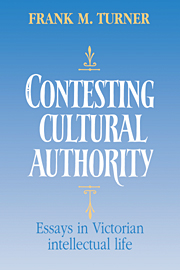Book contents
- Frontmatter
- Contents
- Preface
- I SHIFTING BOUNDARIES
- II SCIENCE AND THE WIDER CULTURE
- 5 Victorian scientific naturalism and Thomas Carlyle
- 6 Rainfall, plagues, and the Prince of Wales
- 7 The Victorian conflict between science and religion: a professional dimension
- 8 Public science in Britain: 1880–1919
- III MODERNS AND ANCIENTS
- Index
7 - The Victorian conflict between science and religion: a professional dimension
Published online by Cambridge University Press: 22 September 2009
- Frontmatter
- Contents
- Preface
- I SHIFTING BOUNDARIES
- II SCIENCE AND THE WIDER CULTURE
- 5 Victorian scientific naturalism and Thomas Carlyle
- 6 Rainfall, plagues, and the Prince of Wales
- 7 The Victorian conflict between science and religion: a professional dimension
- 8 Public science in Britain: 1880–1919
- III MODERNS AND ANCIENTS
- Index
Summary
Was there a conflict between science and religion in late Victorian England? T. H. Huxley, Bishop Wilberforce, John Tyndall, Francis Galton, W. K. Clifford, and William Gladstone certainly thought so. Other contemporaries, such as Lord Tennyson, E. B. Pusey, Frederick Temple, Frederic Harrison, and Herbert Spencer feared so but hoped not. Sermons criticizing the arrogance of scientists and articles decrying the ignorance of clergy, as well as books such as John Draper's History of the conflict between religion and science (1874) and that of his fellow American Andrew White, The warfare of science (1876), with a preface by British physicist John Tyndall, suggested a bitter controversy between spokesmen for religion and science. Early twentieth-century writers including J. M. Robertson, J. B. Bury, Bertrand Russell, and Arthur Balfour assumed that a conflict had raged over the subject a generation or so earlier.
Later commentators were less certain about the existence of the struggle, its dimensions, and even its issues. Robert Ensor regarded it parenthetically as ‘(real enough at the time)’. Charles Raven contended the debate over science and religion amounted to little more than ‘a storm in a Victorian tea-cup’. R. K. Webb explained that the number of people whose religious faith was shaken by scientific discoveries was ‘probably fairly small’ but consisted of ‘people whose opinions counted for much’. Owen Chadwick drew the important distinction ‘between science when it was against religion and the scientists when they were against religion’.
- Type
- Chapter
- Information
- Contesting Cultural AuthorityEssays in Victorian Intellectual Life, pp. 171 - 200Publisher: Cambridge University PressPrint publication year: 1993
- 2
- Cited by



